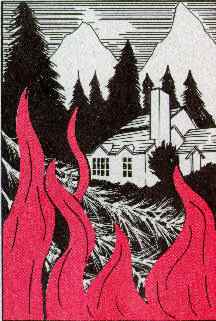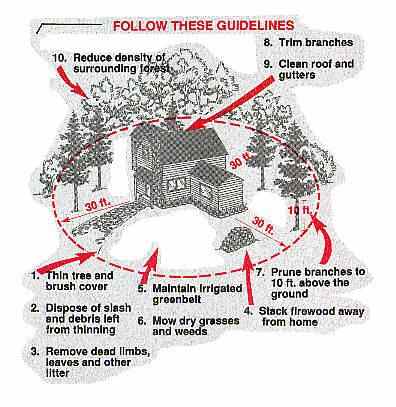

When you build or buy a home in one of the forested/wildiand areas of Boulder County, you have accepted the fact that these areas have poor access, native vegetation, steep slopes, and no fire fighting water supplies. ln ordertoattempt to prevent a tragedy,you need to be aware of wildfire hazards and what to do when a wildfire occurs in your area.
Hopefully, you have already created DEFENSIBLE SPACE around your home and made other improvements to increase the chances that it can survive a wildfire. DEFENSIBLE SPACE is an area of 30 feet or more around your home that is kept free of features that tend to increase the risk of your home being destroyed. Other improvements include improving driveway access and water supplies, having a fire-resistive roof, enclosing overhanging eaves and decks, spark arrestors on chimneys, etc.
Guidelines

USE THIS CHECKLIST TO HELP DEVELOP YOUR OWN FIRE PLAN. Ask your local fire department for advice. Talk with your neighbors about tools, equipment and other resources you could share in an emergency.
![]() Evacuation Plan.
Evacuation Plan.
Early evacuation is the safest way to avoid injury or death. Timing and other factors can vary so widely that each household needs its own specific plan, including options to coveranything that might happen.
![]() Escape Routes.
Escape Routes.
Normal and alternate escape routes.
![]() Safety Zones.
Safety Zones.
Locations of and routes to large areas with little or no vegetation or other fuels where family members can ride out the fire if it's too late to evacuate.
![]() Communication.
Communication.
Pre-arrange normal and alternate ways to stay in touch with family members, even if phones are out. Family members might "check in" with a friend or relative in another area as soon as they're able.
![]() Assignments.
Assignments.
Who is to do what when in an emergency.
![]() Hoses.
Hoses.
Pre-connected to faucets.
![]() Ladder.
Ladder.
Long enough to reach the roof easily.
![]() Fire Extinguishers.
Fire Extinguishers.
One or more 5-pound multipurpose type, readily available.
![]() Protective Clothing.
Protective Clothing.
For -anyone who is unable to evacuate before the arrives.
This includes:
If you see a wildfire, call 9-1-1. Don't assume that someone else has already called. Describe the location of the fire, speak slowly and clearly, and answer any questions asked by the dispatcher.
9-1-1
EMERGENCY PHONE NUMBER
![]() Evacuate.
Evacuate.
Evacuate your pets and all family members who are not essential to preparing the home. Anyone with medical or physical limitations and the young and the elderly should be evacuated immediately.
![]() Wear Protective Clothing.
Wear Protective Clothing.
![]() Remove Combustibles.
Remove Combustibles.
Clear items that will burn from around the house, including wood piles, lawn furniture, barbecue grills, tarp coverings, etc. Move them outside of your defensible space.
![]() Close/Protect Openings.
Close/Protect Openings.
Close outside attic, eaves and basement vents, windows, doors, pet doors, etc. Remove flammable drapes and curtains. Close all shutters, blinds or heavy non-combustible window coverings to reduce radiant heat.
![]() Close Inside Doors/Open Damper.
Close Inside Doors/Open Damper.
Close all doors inside the house to prevent draft. Open the damper on your fireplace, but close the fireplace screen
![]() ShutOff Gas.
ShutOff Gas.
Shutoff any natural gas, propaneorfuel oil supplies at the source.
![]() Water.
Water.
Connect garden hoses. Fill any pools, hot tubs, garbage cans, tubs or other large containers with water.
![]() Pumps.
Pumps.
If you have gas-powered pumps for water, make sure they are fueled and ready.
![]() Ladder.
Ladder.
Place aladderagainstthehouseinclearview.
![]() Car.
Car.
Back your car into the driveway and roll up the windows.
![]() Garage Doors.
Garage Doors.
Disconnect any automatic garage door openers so that doors can still be opened by hand if the power goes out. Close all garage doors.
![]() Valuables.
Valuables.
Place valuable papers, momentos and anything "you can't live without"inside the car in the garage, ready for quick departure. Any pets still with you should also be put in the car.
![]() Lights.
Lights.
Turn on outside lights and leave a light on in every room to make the house more visible in heavy smoke.
![]() Don't Lock Up.
Don't Lock Up.
Leave doors and windows closed but unlocked. It may be necessary for firefighters to gain quick entry into your home to fight fire. The entire area will be isolated and patrolled by sheriff's deputies or police.
![]() This is dangerous and should only be done in an emergency, but you can survive the firestorm if you stay in your car. I t is much less dangerous than trying to run from a fire on foot.
This is dangerous and should only be done in an emergency, but you can survive the firestorm if you stay in your car. I t is much less dangerous than trying to run from a fire on foot.
![]() Roll up windows and close air vents. Drive slowly with headlights on. Watch for other vehicles and pedestrians. Do not drive through heavy smoke.
Roll up windows and close air vents. Drive slowly with headlights on. Watch for other vehicles and pedestrians. Do not drive through heavy smoke.
![]() If you have to stop, park away from the heaviest trees and brush. Turn headlights on and ignition off. Roll up windows and close air vents.
If you have to stop, park away from the heaviest trees and brush. Turn headlights on and ignition off. Roll up windows and close air vents.
![]() Get on the floor and cover up with a blanket or coat. Stay in the vehicle until the main fire passes.
Get on the floor and cover up with a blanket or coat. Stay in the vehicle until the main fire passes.
![]() Stay in the car. Do not run! Engine may stall and not restart. Air currents may rock the car. Some smoke and sparks may enter the vehicle. Temperature inside will increase. Metal gas tanks and containers rarely explode.
Stay in the car. Do not run! Engine may stall and not restart. Air currents may rock the car. Some smoke and sparks may enter the vehicle. Temperature inside will increase. Metal gas tanks and containers rarely explode.
![]() Stay calm.
Stay calm.
As the firefront approaches, go insidethe house. You can survive inside. The fire will pass before your house burns down.
![]() Check the roof immediately. Put out any roof fires, sparks or embers. Check the attic for hidden burning sparks.
Check the roof immediately. Put out any roof fires, sparks or embers. Check the attic for hidden burning sparks.
![]() If you have a fire, get your neighbors to help fight it.
If you have a fire, get your neighbors to help fight it.
![]() The water you put into your pool or hot tub and other containers will come in handy now. If the power is out, try connecting a hose to the outlet on your water heater.
The water you put into your pool or hot tub and other containers will come in handy now. If the power is out, try connecting a hose to the outlet on your water heater.
![]() For several hours after the fire, maintain a "fire watch." Re-check for smoke and sparks throughout the house.
For several hours after the fire, maintain a "fire watch." Re-check for smoke and sparks throughout the house.
![]() The best temporary shelter is in asparsefuel area. On a steep Mountainside, the back side is safer. Avoid canyons, natural "chimneys" and saddles.
The best temporary shelter is in asparsefuel area. On a steep Mountainside, the back side is safer. Avoid canyons, natural "chimneys" and saddles.
![]() If a road is nearby, lie face down along the road cut or in the ditch on the uphill side. Cover yourself with anything that will shield you from the fire's heat.
If a road is nearby, lie face down along the road cut or in the ditch on the uphill side. Cover yourself with anything that will shield you from the fire's heat.
![]() If hiking in the back country, seek a depression with sparse fuel. Clear fuel away from the area while the fire is approaching and then lie face down in the depression and cover yourself. Stay down until after the fire passes!
If hiking in the back country, seek a depression with sparse fuel. Clear fuel away from the area while the fire is approaching and then lie face down in the depression and cover yourself. Stay down until after the fire passes!
Rural areas, especially in the mountains, are not served by city fire departments with fulltime paid fire fighters nor do they have staffed fire stations less than five minutes away.
Boulder County's fire protection is provided by over 25 separate fire protection agencies. Most of these are small fire protection districts staffed by volunteer fire fighters. Fire fighters are present at the fire stations only if they are responding to an emergency, maintaining or repairing equipment, training or attending some other fire department meeting.
BCFFA is the volunteer organization that supports the county's fire protection districts. Some of the services provided by BCFFA include communication, coordination, education and training. mutual aid agreements, disaster response planning and coordination, and wildfire hazard mitigation programs. A number of other agencies, like the Boulder County Sheriff's Department, Colorado State Forest Service, U.S. Forest Service, Bureau of Land Management and other agencies also coordinate with BCFFA and participate in its programs and activities.
For additional information on how to improve your chances of surviving a wildfire, contact YOUR LOCAL FIRE DEPARTMENT or one of the other agencies listed below. Ask about other written materials and the availability of video tapes on the subject.
If you don't know the name of the Fire Protection District that serves your property or who to contact there, call the:
Boulder County Sheriff's Department
Emergency Services Group
441-3647
Colorado State Forest Service
936 Lefthand Canyon Drive
Boulder, Colorado 80302
442-0428
Boulder County Land Use Department
Building Safety & Inspection Services Division
P.O. Box 471
Boulder. Colorado 80306
2040 14th Street
Boulder, Colorado 80302
441-3925
City of Boulder Fire Department
Wildland Fire Coordinator
1805 33rd Street
Boulder, Colorado 80301
441-3350
Wildiand/Urban Interface Committee
Boulder County Fire Fighters Association
Building Safety & Inspection Services Division
Boulder County Land Use Department
| Last Update: by the Emergency Services Center Developer BCN Home Feedback About BCN Donate Search BCN Volunteer! |